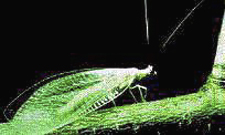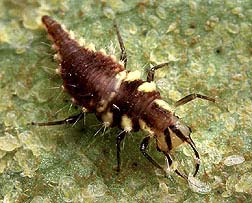Adult Green Lacewing

Most often you will see the adult Lacewing (above) at night on a wall by your porch light. Don't kill them, just let them be so they can lay their eggs. The eggs hatch into the agressive and hungry Larva pictured below.

Adults are light green with long slender antennae, golden eyes and long delicately veined wings that are1/2 to 3/4-inch long. C. carnea can be identified by the dark straight line on the side (genae or cheeks) of the head, which runs from the eye to the mouth. Its body is green with a wide pale stripe along the top of the body. C. rufilabris has red genae and black cross veins. Larvae grow to 1/2-inch long and have spindle-shaped bodies with prominent pincher-like mouthparts, resembling tiny alligators. Larvae of both common species have two stripes on the head, but they are straight-sided on C. rufilabris while those of C. carnea widen towards the back of the head.
Adult Green Lacewings eat pollen and nectar from flowers. They also eat honeydew, a liquid made by aphids and scale insects.
Lacewings sometimes release a bad-smelling fluid when attacked by predators. Some predators of lacewings include birds, bats, and larger insects.
When adults visit flowers for nectar, they may accidentally help pollinate a plant, which helps it to make seeds and spread.